
How to Build an Online Community for Your Business
The author's views are entirely their own (excluding the unlikely event of hypnosis) and may not always reflect the views of Moz.
Every day, things are changing in SEO. If you’re not already working on adapting, today’s the day.
It’s time.
It's not that SEO is dead or that links are obsolete, or whatever all that crazy talk is that's been going around. It's that there's a way to integrate all the pieces into the big picture of building a better company by building an online community around it.
There are lots of benefits to building a community around your company, but if I had to choose a few, here are my top five:
-
It will help you weather Google’s algorithms
Building an online community is one of the best ways to weather Google’s algorithms. If you're continually chasing the algorithm, you're putting all of your power in what Google's going to do next. If you're building a community around your business, you're putting the focus where it belongs: on your business. Building a strong company and brand isn't something that Google can take away.
-
It will add equity and value to your business
When you build online community, you have to do a bunch of stuff to better serve your customers like creating quality content and resources, enhancing your product or services, and improving your systems and processes. Doing these things adds equity and value to your business and attracts the right customers to your community.
-
It will help you have purpose
There’s a lot of effort involved in building a community around your brand, and it’s not just about creating content or being on social media just because everyone else is doing it. When you’re strategic about community building, it forces you to identify goals and put a solid purpose behind your efforts.
-
It will help you stand out
If you’re committed to the process of building a community, you are going to be doing a great deal of self-discovery (which often times can be pretty uncomfortable). During this process you’ll determine what you’re all about, what you love to do, and what it’s going to take to help you stand out among the competition.
-
It will put the focus on goals, not tools
Building an online community isn’t a bunch of fluffy stuff. It’s the seamless integration of tools like SEO, social media, content marketing, email marketing, and all kinds of other important stuff (like hard work and passion). But in order for the tools to be effective, they’ve got to be driven by a strategy that is rooted in the goals of your whole business.
In the last year, Mack Web has been working on building our own community (and helping our clients to build theirs). What we’ve found (through a whole lot of trial and error, joy and pain, sunshine and, well, you get the point) is that building community means building a better business. It’s a necessary online component for growth as it forges and fosters relationships that are essential to building a business online as you would in person.
A present for you
For the past several months, I have been writing a lot about community. How to build it with value, how to identify it, and how to attract customers to it. And now, lucky for you, I'd like to share our process for how to build an online community for your business.
What follows is a super awesome infographic and the play-by-play breakdown of each step in the process. I'm thinking it might come in handy (you can even listen to my webinar for the full effect).
Whether you’re building a community from scratch, or you’re working to grow an existing one, you can use this process to get your community rolling or optimize and leverage what you already have.
The order in which you attack this may differ depending on the size of your organization, your goals, and the stage you’re in as a company. I encourage you to take this process and meld it into what works best for you.
Here we go!

And, in case you want to steal this, here's the embed code ('cuz we're nice like that).
<p><center><img src="http://www.mackwebsolutions.com/img/mozimages/how-to-build-communities.jpg" width="540"> <br/>An infographic on <a href="https://moz.rankious.com/_moz/blog/how-to-build-an-online-community-for-your-business">How to Build an Online Community</a> by the team at <a href="http://mackwebsolutions.com/">Mack Web Solutions</a></center></p>
Let me break that down into stages for you:
[1] Define your business objectives
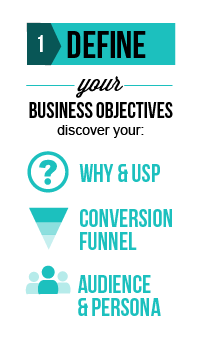 Let’s start this entire process out right by thinking about your goals. What you want to focus on here is defining objectives for your entire business, not just for SEO, social media, content, or marketing. Stay focused on the whole picture of what you want to do with your company.
Let’s start this entire process out right by thinking about your goals. What you want to focus on here is defining objectives for your entire business, not just for SEO, social media, content, or marketing. Stay focused on the whole picture of what you want to do with your company.
Keep in mind that there’s a lot more to defining business objectives than just writing down a bunch of goals. So before you do that, think about this:
-
What makes your company unique?
Especially when you’re a new business (but this happens with old ones, too), it’s easy to feel like you need everyone to be your customer. But the fact is, what you really need are the right customers.
Take Coke and Pepsi; Hershey and Dove; and Chipotle and Qdoba. All companies who sell similar products, but attract very different customers to their brand and their communities. Both are good (and to many people, taste the same). So what’s the difference? Why would someone be attracted to, say, Chipotle over Qdoba?
Chipotle’s food has integrity. They serve sustainably-raised food. They support local farmers. They respect the environment. Because of these values, Chipotle attracts people who have similar philosophies and approaches to food and life.
Qdoba is about quality ingredients. These are very similar things, but the difference is something that people find common ground with, feel strongly about, and want to stand behind. It’s not just about the food. It’s what they believe in. It’s what makes them unique. And people want to be a part of that.
So, determine what your unique selling proposition (USP) is. Do an analysis of your competition. What do you do differently than them (no matter how small)? How is that remarkable? Why does it make you special? That’s your USP. Own this and make it part of everything you do. On and offline.
-
Why do you care?
Simon Sinek can probably say this a whole lot better than I can, but here it is: what is it that makes you care about your business? What keeps you pushing forward (especially when you want to quit)? The reason that you care has nothing to do with money, so besides that, what’s important?
That passion that you feel for your business is not only a significant differentiator, but it’s part of your story and it’s far more motivating than money. Keep this sucker in your back pocket. You’re gonna need it.
-
What do you want to build?
What’s your vision for your company? Think six months, eighteen months, and three to five years. What is it that you really want to do? Dream some of that stuff up and start making a list. You may even want to write down things that are currently on the horizon. Big changes, events, product launches, stuff like that. This will help you to begin defining the goals you have for your business both short and long term.
-
Who do you want to build it for?
This is the part where you get really clear about who your customer actually is. What are their fears, concerns, and challenges? What are the problems (big and small) they would like to solve? Talk to them. Survey them. Ask them.
Organize your audiences into groups. Build some personae around them so that they are real, live, tangible people (find a photo for them and everything). These are your targets.
It will also help to understand your conversion funnel and how that relates to your audience. What do your customers need during the different stages of the funnel? All of this good stuff is going to help inform your strategy (and eventually you’re going to want to create the content and resources to serve those needs).
Just remember that every person on the web is not your customer. Go back to that USP that you’ve just defined. Focus on that and the people who resonate with it, and do whatever it takes to keep the emphasis on them.
The answers to all of these questions will help get to the root of what you’re working so hard for in the first place. From there, you can determine what you really want to do with your company. Then you can identify the goals you’d like to work toward (start with just a few). Once you have those defined, let’s talk about your team.
[2] Elect your team
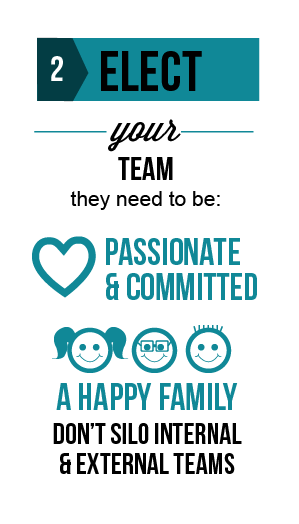 We’ve been around the block a time or two on this community building thing, and there are many things that can become roadblocks. Team selection is one of them.
We’ve been around the block a time or two on this community building thing, and there are many things that can become roadblocks. Team selection is one of them.
Here’s a few tips for getting the right team in place so that you can start working toward achieving your goals:
-
Understand the roles
Building community is no joke. There’s a lot of work to be done and many roles that will need to be filled. If you work with an outside agency, they will bring most of the power, but you play an integral role. Keep in mind that an agency is meant to be your collaborative partner, and not just your mask. It’s your company, after all, so it’s important that you’re present.
If you’re among the brave souls who are going to tackle all of this hard work internally, here’s a run down on some of the typical roles that your team may need to execute: (Please note that I’m not suggesting that you hire someone to fulfill each of these roles. I’m simply providing an overview of the different roles that are part of the community building process. Within your team, there will be individuals who can take on several of these roles).- Project management: Someone to keep all of the peeps on schedule and on task .
- Community management: Someone who can represent your company on social media, monitor, and manage the rest of your team who’s on there as well (pro tip: read Marty Weintraub's book on community management).
- Design: Someone who can create any graphic assets that you need and make you look really good.
- Content: Someone who can write (like the dickens).
- SEO: Someone who loves research, analysis, keywords, and Google so that they can properly and effectively manage the optimization of all content. Ideally you want this dude to be more than passingly familiar with strategy as well.
- Email marketing: Someone who can design, develop, and coordinate email marketing campaigns to deliver the value your team is creating in relationship to your strategy.
- Reading & learning: Several someones who are continually reading and learning about your industry and looking for good stuff to pass around your community (that isn’t about you) . More on this below, but this reading and learning stuff is incredibly imperative to success.
-
Outreach: Several someones who are developing relationships and helping to keep those people and your community involved in what you’re doing (so that they can partake and benefit, too).
Also, because building community is a long-term, ongoing process, I wouldn’t recommend assigning the really integral roles (like community manager) to short-timers or interns. Of course, many companies have limited resources, so do what you can with what you have and just be consistent as possible with your efforts.
-
Elect, don’t just assign
Thing is, especially if you’re a smaller company, you’ve got to work with what you have. Not every company has the luxury of bringing on an outside agency or hiring additional people to share the load of all of this stuff. But if you want these efforts to be successful, you’ve gotta have a team of people who are passionate and committed to seeing this thing through, even when it’s tough and you want to give up.
Instead of just assigning tasks and dumping a bunch of (usually un-welcome) work on people, elect people for your implementation team who are committed to the success of the organization and are passionate about things like your company, social media, content, SEO, and communication. Oh, and humans. You’ve got to have people on this team who want to be there or your efforts will fail. Make it a selection process so that the team feels honored to be part of this whole thing (because it really is a movement).
-
Work together as one, big, happy family
Whether you’re working with internal and external teams, a whole bunch of interdepartmental teams, or a mix and match of both, do whatever you can to come together as a unified team (more on this below). Whatever you do, don’t silo. Collaborate and be friends. It will make all of the difference in the end.
Keep in mind that this team you’re putting together isn’t just going to be working on your marketing; they’re going to be playing an integral role in transforming your business. Do what it takes to be sure everyone is on the same page and working together to make things happen.
[3] Develop your strategy
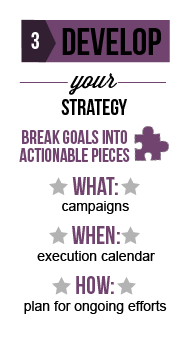 Developing a strategy is what will actually help you to achieve your goals. A good strategy will assist you in breaking those high level goals down into actionable, chewable pieces that you can work towards and even measure.
Developing a strategy is what will actually help you to achieve your goals. A good strategy will assist you in breaking those high level goals down into actionable, chewable pieces that you can work towards and even measure.
Think about strategy in three pieces: the what, the when, and the how.
-
The what: campaigns
Campaigns are where your goals meet your ideas. What is it that you’re going to need to create in order to actually accomplish your goals? Everything from your tangible assets like blog posts, videos, and infographics; to webinars and events like tradeshows, conferences, speaking engagements, and meetups.
If one of your goals is to become a trusted resource in your industry (a thought leader), then you’ve got to figure out what it’s going to take to accomplish it. Maybe it’s a four-part series that involves a mix of instructional videos that are integrated into blog posts, in-person lunch-and-learns or meetups, and maybe a speaking engagement at a conference. Whatever it ends up being, your campaigns need to break down all of the nitty gritty (and creative) detail of what is going to happen to take this bigger picture to fruition.
But whatever you do, don’t plan the campaigns in your strategy for 12 consecutive months. It really makes it hard for the team to be agile and embrace stuff that comes up. We have found that every few months, it’s time to develop a new strategy (based on the data we’ve collected and the stuff that we’ve observed).
Figure out what’s working and put your efforts (and your money there). Things are going to happen. Your business will change, you'll have a big victory that you want to explore further, you'll discover an opportunity that you didn't realize existed. So keep the higher level, 12-month plan in mind, but plan campaigns for 2-3 months at a time.
-
The when: execution calendar
Once you know exactly what you want to do, you’ve got to figure out how long it’s going to take. Develop a high level execution calendar that illustrates the coordination of all assets and vehicles over a two to three month period (long enough to collect some data, but, again, short enough to be agile and change direction). Your calendar may look something like this:
.png)
You’ll also want to take all of those high level ideas and break them down to assign them to actual people with real due dates. We do this in Basecamp and Gcal, but anything that allows you to assign deadlines will do the job.
-
The how: ongoing efforts
The how is your plan for everything that needs to happen and continue to happen to make your efforts a success (people, assets, actionables). The biggest thing ongoing is to keep your commitments and stay accountable for the stuff that has to get done. But a really big (and important) part of ongoing efforts is continual analysis of your efforts and goals to make sure you’re always headed in the right direction (more on measurement and analysis below).
Thing is, there is no formula. You’ve got to be creative, try things out, and do what works for your business. Throw some stuff out there and see what happens. Make some educated decisions about that data and go from there. After a few campaigns you’ll get to know what works for your community and you’ll start to gain some traction. It’s all part of the process.
[4] Empower your team
 Once that you’ve figured out what, you’re going to do to work toward your goals (with your super awesome strategy). Before you jump into go-mode, take some time to set the team up for success.
Once that you’ve figured out what, you’re going to do to work toward your goals (with your super awesome strategy). Before you jump into go-mode, take some time to set the team up for success.
Do not skip this step.
I repeat. This step is important. Don’t skip it.
Depending on the climate (and culture) of your company (or the company you’re working with), there’s going to be some fear, concerns, and even resistance that you’ll get from your team (even if you think everything is A-OK). Rather than ignoring it and pushing through, hit it head on. Talk about it. Get it out in the open. You’ll be glad you did.
You can empower your team for success by addressing a few simple questions:
-
Why are we doing this?
Here’s your chance to build confidence and trust. The biggest source of resistance we run into is with teams who are afraid of the online space and of being on social media. Help your team understand that building an online community is not just about social media. It’s about working toward the goals that you have for your company. Social media is just one of the vehicles. If you use it effectively, you’re going to learn a ton of stuff, meet some really cool people, and turn up some pretty amazing opportunities.
-
How much work is involved?
When people have a sense of purpose, they are more inclined to put the effort forth. Is there going to be a lot of work involved? Yes. Is it going to be hard? You betcha.
That being said, now’s your chance to reassure your team that you’ve taken the time to identify goals for the company and have developed a strategy that’s going to help achieve those goals. You have a purpose.
Explain how the campaigns that have been developed in the strategy align with your specific goals. Also, let your team know that there is a learning curve for all of this and that you don’t expect them to know what they’re doing right off the bat. Integrate training for your team as an ongoing thing. Training that focuses on skills as well as approach. This will motivate them and help them to feel useful and powerful.
-
When will we see results?
Let me be very clear about this. You can measure ROI in community building, but it’s not as simple as measuring a cell phone case purchase in a shopping cart. You’ve got to be creative about what and how you measure and know that it takes time to see results. And sometimes the stuff that brings ROI cannot be easily measured.
When discussing expectations about results, be realistic. Don’t sugar coat it. Building (or growing) a community takes time (and a lot of work). And so does accomplishing goals. Especially big ones. It’s important that you have open communication with the team about what can be expected in the long and also the short term.
We like to talk about examples of what the little victories look like. Like getting recognized for a good piece of content with a retweet on Twitter. Or a lead that was generated through a good conversation you had with someone on Google+. Again, it’s the same stuff you do when you’re building your business in person. You’re just doing it online.
For the long term, we focus on realistic timeframes for their goals based on the steps we’re taking with their strategy. If the goal is thought leadership, and depending on the stage the company is currently in (are we starting from scratch?), there will be a whole lot of leg work (and foundational work) that has to be done. Like many goals, this stuff doesn't happen overnight.
Discuss KPIs (that you all can agree on) that will provide the proof that your efforts are working. Maybe it’s a series of actions like downloading a whitepaper, attending a webinar, or being asked to speak at a conference. If these are the actions, determine how you’re going to track them (in Google Analytics or wherever else you want to collect the data), and then you’ll have the data to report on each month (more on communicating measurement below).
One last thing on results. Remember that you may not ever reach the goals you set out. But certainly what can happen along that journey can be even more rewarding. Stay present and pushing forward.
The biggest thing to remember with empowering your team is that you have to help them disrupt their routine. Building community is about learning, growing, and pushing your company into new spaces. You can’t do this by tacking all of this new work onto the same routine you’ve been using for the last 5 years. You’ve got to start new. Disrupt your routine and start new. And then get ready for the long haul.
[5] Learn your industry
 You can’t grow a business in a vacuum. If you want to stand out and be successful, you’ve got to be learning and growing.
You can’t grow a business in a vacuum. If you want to stand out and be successful, you’ve got to be learning and growing.
All. The. Time.
One of your number one priorities in marketing your business online is providing the best possible customer experience. And you can’t do that if you’re not learning continuously.
You can start by identifying your community and determining the blogs you want to be sure to read, the people you want to get to know, and companies that you will want to keep tabs on.
Embracing the knowledge in your industry is going to push you to be more creative, innovative, and agile. It’s going to open up opportunities that you didn’t even realize existed. But that won’t happen if you don’t dedicate the time to it on a consistent basis.
Learning takes place everywhere. So step away from your computer and meet some people (for Dr. Pete’s sake). Make new friends, find people who have a strength that you need to work on and ask them to mentor you. Build friendships with super cool people and companies. This is really the most important part.
Then go back to your computer and read a lot. More than you ever have in your whole life. Read the good stuff inside of your industry and outside of your industry. You’re going to see some cool stuff that will open up your world (that, my friends, is why it’s called the world wide web).
All of this stuff is what manifests serendipity and although that’s the hardest stuff to measure, it’s also what ends up making the biggest difference when building a community (and a business).
[6] Create the value
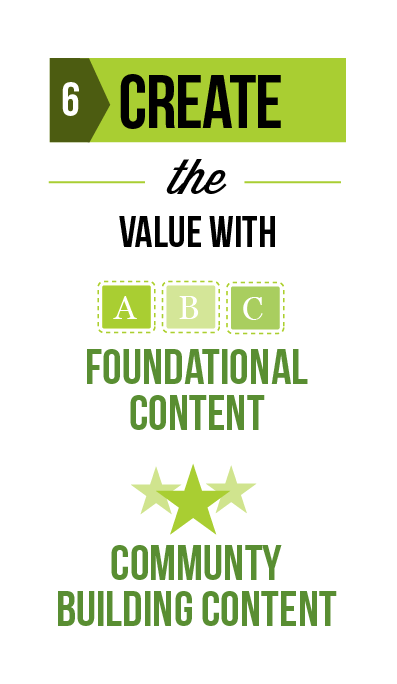 Ok, now we’re getting to the real good stuff. Value is what your community is built upon, whether that’s “tangible” stuff like blog posts, videos, resources, and tools; or an approach, perspective, or virtue that is the basis for common ground. Value that focuses on your customer and their experience is what attracts people to your business, your brand, and your community.
Ok, now we’re getting to the real good stuff. Value is what your community is built upon, whether that’s “tangible” stuff like blog posts, videos, resources, and tools; or an approach, perspective, or virtue that is the basis for common ground. Value that focuses on your customer and their experience is what attracts people to your business, your brand, and your community.
In general, there are two types of content that will help build your community: foundational and community building.
Foundational content is the more static stuff on your website (like your about and services sections), like pages that explain who you are and what you do. The problem with most foundational content is, let's be honest, that it kind of sucks. It’s really focused on self-promotion (as it should be; it is, after all, your website) instead of being geared toward the needs of your customer.
The challenge with foundational content is to listen to your customer. Observe their needs, the things in life that they struggle with, and then communicate how your products or services address those things. Use video and resources and case studies and infographics to provide an engaging and value-packed experience and make your foundational content worth reading (and worthy of links).
Community building content is the stuff that’s more dynamic in nature and usually lives on your blog. It’s the content that is less about what you do and more about what you know.
Community building content is the easiest stuff to make all about your customer because the purpose of building it is to help them understand your knowledge and expertise. This type of content indirectly promotes your brand, establishes trust and credibility, and really helps to foster relationships.
Just like your foundational content, this stuff needs to be full of your personality. Show who you are, what you believe in, and how you approach stuff. Balance your content with risky stuff and things that may help you stand out a bit. All in an effort to help your customers (current and potential) learn so that they’ll pass it around to their friends and come back later for more.
Here’s a few more things to remember when you’re generating your content:
-
It’s not about you
Make your content about your customer, not about you. Focus on their needs. And don’t just guess, ask them. Do an email survey, or make a phone call, or take them to lunch. Listen and figure out how you can better serve them and then actually apply the feedback to the content and resources you’re creating.
-
Don’t forget about SEO
SEO is an integral piece when building community and content. Certainly your content will be part of your well-planned strategy, but before you create it, don't forget to find out what’s already out there. Does what you're about to write already exist (in some form)? If so, find a way to do it better so that Google has a reason to index it and present it as the best option when someone conducts a search.
Don’t forget the importance of covering your SEO bases and doing the basic on-page stuff. Do some keyword research and properly integrate it into your content so that people can actually find your stuff.
-
Use pre-outreach
Thanks to this tip from Rob Ousbey, pre-outreach has been one of the most powerful tools in our arsenal. Getting the word out about good stuff you’re doing is a lot harder if you don’t involve your audience in the process. Before you even create your content, think about who you could talk to, interview, survey, engage with online, and get valuable feedback that could help make your content more purposeful and more successful.
[7] Share the value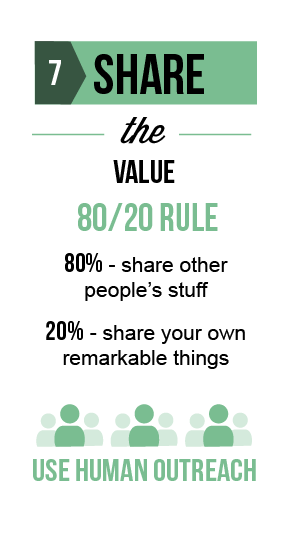
You may have heard me mention this once or twice, but the way in which you share the value that you (and others) create, is one of the most important pieces (and accelerators) when building community and your business.
It works like this: 80% of the time, share other people’s great stuff. But don’t just retweet it or hit the share button and place it on your feed. Read it. Internalize it. And then curate it. Tell people why it’s good. This helps you learn and also keeps the focus where it belongs: on the value that you're providing for the reader.
20% of the time, share your own stuff, but make it remarkable. This is the community building stuff that we just talked about. The stuff that provides a wealth of knowledge that people will thank you for.
And remember that just building something amazing, doesn’t guarantee that people will see it. That’s why there’s outreach (so do it, dude).
Outreach is code for making friends and being an authentic human before you even think about asking for anything. Build relationships with people online as you would in person. Then, when you’ve got good stuff to get out, they’re going to be excited to spread the word.
Whatever your ratio is: 60/40, 70/30, 90/10, remember that it’s not about you. Stay focused on your customer and test out what works best for your community.
[8] Build and foster growth
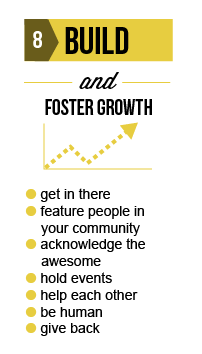 This is the part that never, ever ends (that's a good thing). Building and fostering community is synonymous with building and growing your company. You’ve got to work at it. All the time.
This is the part that never, ever ends (that's a good thing). Building and fostering community is synonymous with building and growing your company. You’ve got to work at it. All the time.
There are lots of things that you can do to foster and grow your community. Here’s just a few:
-
Get in there
Remember that you are a member of your community. You and your entire team. Get in there. Play an active role. Contribute and engage on a genuine level. It’s an extension of your company and your brand and it’s important to the growth of your community.
-
Embrace offline efforts
It’s so important to cultivate relationships with people in person. It’s an integral piece to growing your community. When you form a bond in person, it’s even more powerful online. So go to events and hold events. Ask people to coffee. Go to meetups and conferences. Embrace the offline, in-person, human stuff as much as you do with your work online. Meet people face-to-face and learn more about them. It will really help to build your community and your business.
-
Acknowledge and show appreciation
Don’t forget that a community comprises living, breathing people who are supporting you. There are lots of great ways to show your appreciation, so make sure you set the time aside in your routine to acknowledge the humans in your community.
Of course you can always give them stuff. Providing free swag at events or sending it out as a thank you or just because is a great way to show appreciation and turn your members into your brand ambassadors.
Be on the lookout for community members who are doing great things in their own businesses or lives. Recognize their good news and hard work and give them a virtual pat on the back. Engage with your community members and ask them if there’s anything you can do to help them. It’s a great way to create the content and resources they need that will also benefit others.
[9] Measure and analyze (and communicate)
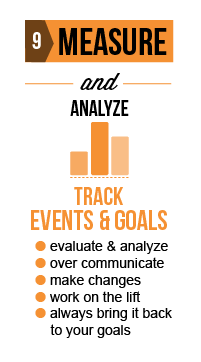 This is the juicy part (and just because this is listed as the last piece in the process doesn’t make it any less significant). In fact, you’ll want to make sure that you’re thinking about measurement and analysis all the way through.
This is the juicy part (and just because this is listed as the last piece in the process doesn’t make it any less significant). In fact, you’ll want to make sure that you’re thinking about measurement and analysis all the way through.
Measurement and analysis is an ongoing process when building community. Everything you do will include testing, feedback, measurement, analysis, adjustments, rinsing, and repeating. And then, you’ve got to communicate this data to your team (and/or your client).
Here’s a few thoughts about measurement & analysis, but also ongoing, old-fashioned communication:
-
Weekly stand-ups
When we’re helping clients build their communities, it’s a very collaborative process. There are lots of things that we do on their behalf, but there’s also some integral pieces that we need them to execute consistently and timely.
We hold stand-ups every day as a team, and they work so well that we thought we’d try them out (once a week) with our clients. We don’t talk metrics at these meetings. Just a quick 10 minute meeting to get on the phone, a G+ hangout, or via Skype so that we can get connected for the week. This has really helped to boost motivation and keep the momentum of the strategy that we’re all working to implement.
-
Bi-weekly pushes
In addition to the weekly standups, we also do a little electronic pushing over email every two weeks. This is really just a collective here’s what’s going on reminder to again, keep the momentum. We used to do these in a document, but that wasn’t getting the response we needed, so we switched to a straight up email with a little "action required" nudge in the subject line.
-
Monthly reports
Monthly reports tend to be the best way to communicate all of the hard work you’ve been doing, but also prove that you’re making some headway on those goals you’ve set forth. In those reports, showcase the data that you’ve collected and then present it in a way that is meaningful to the client so that they can easily see how this is affecting their business.
Your goal with monthly reports is to illustrate the value you’re providing and the progress you’re making. But don’t just send these reports via email. Take the time each month to review (face-to-face) what’s been going on, and talk more specifically about how efforts are helping to reach goals (which equates to ROI).
Remember that it’s your job to provide the analysis. What does this mean to their business? Are efforts (and dollars) being spent in the right places? If you’re experiencing victories, share them. If the data doesn’t look good, tell them why and then what you’re going to do about it. That’s what the data is for. Analyze it and then use it to make decisions about your efforts moving forward.
-
Quarterly strategy
At quarter's end, take a higher level look at what’s going on. Can you spot trends in content, social behavior, traffic? How does that affect efforts and what needs to be done with the strategy to adjust? Just make sure you’re always bringing this stuff back to goals. Assess the journey and then figure out what needs to be done to change course and put a new plan into action.
Now it’s your turn
As you take this process and work to implement it into your company or with your clients, keep these final things in mind:
-
This is about building a brand
At the heart of building community is becoming the company you’ve always wanted to be. Stay rooted in your passion for your business and remember that your efforts go far beyond your marketing. You’re working to build a brand and a company that you can be proud of and that people want to be associated with.
-
Stay grounded in your goals
Whether you’re a one-person band, or a humungo company, there’s a lot to tackle with all of this good stuff. That’s why a strategy is so important. But you won't have a strategy to stand on if you haven't clearly defined your objectives for your business. Make sure you always come back to your goals. These are the foundation for all of the hard work you’re doing. Always put your focus on goals, not tools.
-
Don’t give up
The number one question in all of this is when are we going to see results? How long does it take before something really great happens? Unfortunately there’s no formula with this stuff so there’s no straight way to answer these questions.
What I do know is that results come in different forms and different sizes for every company.
For Mack Web, it took us about a year of working through this process for our company before we started to gain traction, but that was after we’d already been in business for 10 years. If you want to achieve results, you’ve got to be willing to fail for a long time before you start seeing the wins. But if you can stick with it, you won’t be sorry (this is what happened to Mack Web's traffic in just a 10 month period of facilitating this process for our company).
What have I missed? What great things are you doing to build your brand and your community? I would love to hear more in the comments below.



Comments
Please keep your comments TAGFEE by following the community etiquette
Comments are closed. Got a burning question? Head to our Q&A section to start a new conversation.